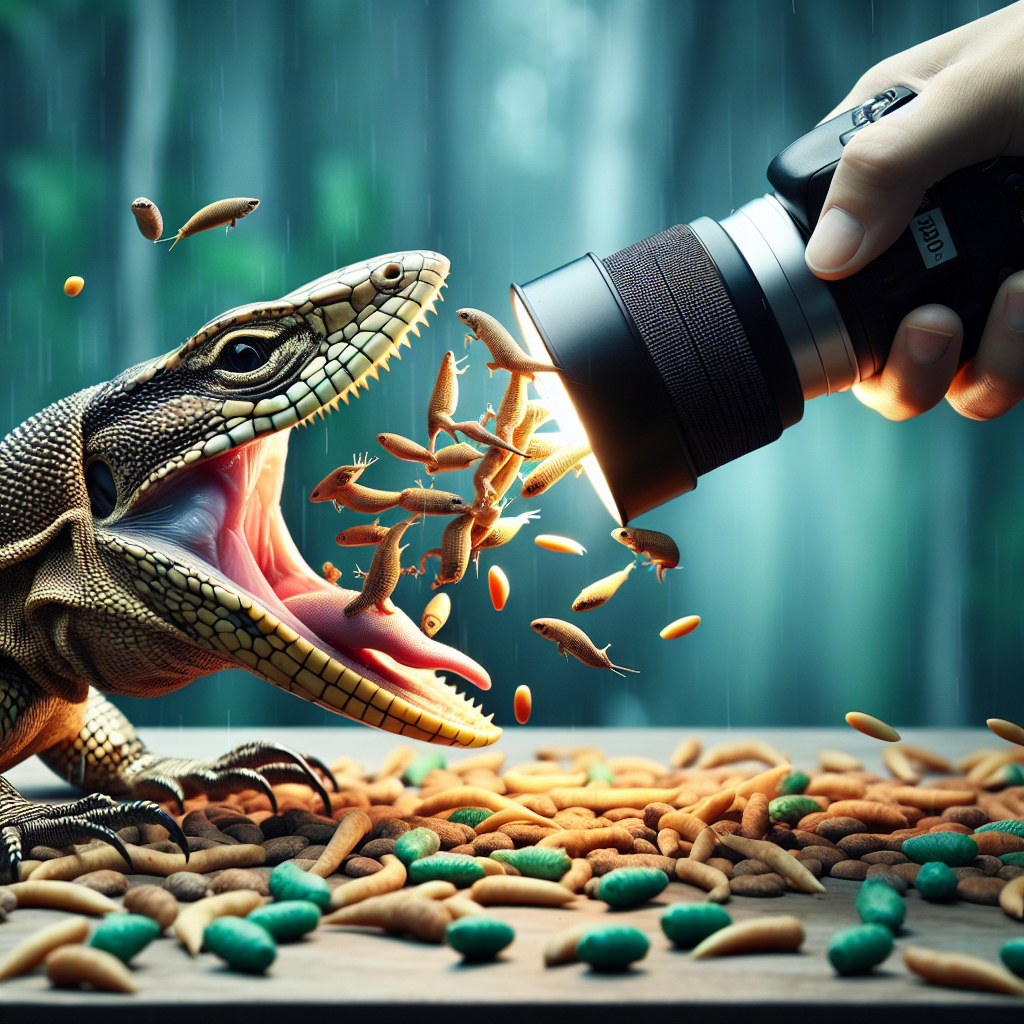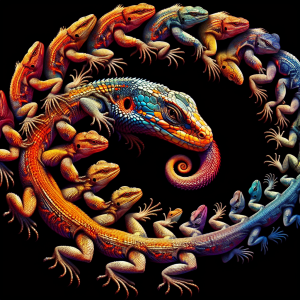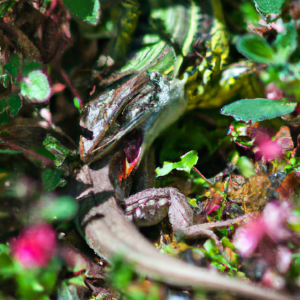Introduction to Captive Lizard Feeding Behaviors
Lizard feeding behaviors in captivity are truly fascinating. Picture this: you’re observing your pet lizard hunt down its meal, a captivating sight. Did you know that lizards have diverse dietary needs based on their species and size? It’s crucial to provide a well-balanced diet to ensure their health and happiness.
One key tip I always share with lizard owners is to research the specific dietary requirements of their pet’s species. This knowledge empowers you to create a feeding plan tailored to your lizard’s needs. Monitoring your lizard’s feeding behaviors is another essential aspect. Are they eating enthusiastically or showing disinterest? These cues can indicate their health and well-being.
Now, let’s delve into the types of food suitable for captive lizards. From insects and worms to fruits and vegetables, the options are varied. Understanding what your lizard enjoys and benefits from is vital. Additionally, establishing a consistent feeding schedule promotes a healthy routine for your pet.
As you navigate the world of captive lizard feeding behaviors, remember that each lizard is unique. By observing, adapting, and providing a nutritious diet, you’re ensuring the best care for your scaly companion. So, let’s embark on this exciting journey together and nurture our beloved lizard friends with care and knowledge.
Understanding the Dietary Needs of Captive Lizards
Understanding the dietary needs of captive lizards is crucial for their health and well-being. When it comes to feeding these fascinating creatures, you need to think beyond just tossing them any old food. Captive lizards have specific requirements that must be met to keep them happy and thriving.
Imagine you’re at a buffet with only a few food options that you can eat every day. That’s pretty much what it’s like for captive lizards. They rely on us to provide them with a balanced and nutritious diet that mimics what they would eat in the wild.
Did you know that different species of lizards have varying dietary needs? Some are strictly herbivores, while others are carnivorous or omnivorous. It’s essential to research your specific lizard species to ensure you’re offering the right types of food.
One practical tip for feeding captive lizards is to offer a variety of food items to ensure they’re getting all the necessary nutrients. This can include live insects, fruits, vegetables, and even commercial reptile diets.
The challenge lies in finding the right balance and ensuring your lizard is getting everything they need to stay healthy. By understanding their feeding behaviors and preferences, you can create a feeding schedule that works for both you and your scaly friend.
Remember, proper nutrition is key to keeping your captive lizard happy and healthy. So, dive into the world of captive lizard feeding behaviors and watch your pet thrive under your care.
Types of Food Suitable for Captive Lizards
When it comes to feeding your captive lizard, understanding the types of food suitable for them is crucial. You want to make sure you’re providing a balanced diet that meets their nutritional needs.
Let’s imagine you’re at a gourmet buffet, but instead of choosing from a variety of dishes, you have to select the ones that are perfect for your scaly friend. Think of your lizard as a picky eater with specific preferences – they might not appreciate the same treats as you do!
Did you know that different species of lizards have varying dietary requirements? Some lizards are herbivores, while others are carnivores or omnivores. It’s essential to research your specific lizard species to determine the best food options for them.
Imagine trying to feed a salad to a lizard that craves insects or vice versa – it’s like offering a vegetarian burger to a meat lover! Understanding your lizard’s natural diet in the wild can guide you in selecting the right food for them in captivity.
By providing a diet that mimics their natural feeding behaviors, you can ensure your pet lizard stays healthy and happy. So, next time you’re preparing a meal for your scaly companion, consider their dietary needs and offer them a menu that suits their taste buds!
Feeding Schedule and Frequency for Pet Lizards
Feeding your captive lizard may seem straightforward, but there’s more to it than meets the eye. Lizards have specific dietary needs that require careful attention to ensure they stay healthy and happy.
When it comes to feeding your pet lizard, one essential factor to consider is the type of food you provide. Lizards are diverse creatures, with some being herbivores, others insectivores, and some even omnivores. Understanding your lizard’s species-specific diet is crucial for their well-being.
An interesting fact about lizard feeding behaviors is that some species have evolved to eat a variety of foods in the wild, which can make replicating their natural diet challenging in a captive setting. For example, bearded dragons are omnivores that require a mix of insects, fruits, and vegetables to thrive.
To ensure your captive lizard receives the proper nutrition, it’s important to establish a feeding schedule and frequency that align with their dietary requirements. This consistency not only helps maintain their health but also establishes a routine that can reduce stress for your pet.
Experimenting with different types of food and observing your lizard’s feeding behaviors can provide valuable insights into their preferences and nutritional needs. By monitoring their eating habits closely, you can make adjustments to their diet as needed to promote optimal health and vitality.
Remember, each lizard is unique, and what works for one may not work for another. By staying attentive and responsive to your pet’s feeding behaviors, you can cultivate a strong bond while ensuring they receive the best care possible.
Factors to Consider When Feeding Captive Lizards
Feeding your captive lizard is a crucial aspect of their care, but did you know that their dietary needs can vary based on their species? Each type of lizard has its own unique preferences and requirements when it comes to food. For example, while some lizards thrive on a diet of insects and small prey, others may prefer a more plant-based menu.
Understanding the specific dietary needs of your lizard is essential for their health and well-being. Providing a varied and nutritious diet is key to keeping your pet happy and thriving. It’s like creating a custom meal plan tailored just for them!
One practical tip to ensure your lizard’s diet is balanced is to offer a variety of foods, including live insects, fresh fruits, and vegetables. This not only provides essential nutrients but also keeps mealtime exciting for your scaly friend. Imagine the joy of watching them eagerly devour their favorite treats!
By monitoring your lizard’s feeding behaviors and preferences, you can fine-tune their diet to suit their individual tastes. Just like us, lizards have their own food preferences, and experimenting with different options can help you discover what they love most. So, why not embark on a culinary adventure with your lizard and see what delights their taste buds?
Remember, a well-fed lizard is a happy lizard! By taking the time to understand and cater to your pet’s dietary needs, you’re not just providing them with sustenance – you’re nurturing a bond that will last a lifetime.
Monitoring and Adjusting Feeding Behaviors
Have you ever observed your captive lizard’s feeding behavior and wondered if it’s normal? Well, let me shed some light on this interesting topic. When it comes to monitoring and adjusting your pet lizard’s feeding habits, there are a few key things to keep in mind.
First off, consistency is key. Lizards thrive on routine, so try to establish a regular feeding schedule. This helps them feel secure and ensures they receive the necessary nutrition.
Another important aspect is portion control. Just like us humans, lizards can overeat, leading to obesity and health issues. It’s crucial to provide the right amount of food based on your lizard’s size and species.
Now, let’s talk about variety. Lizards love a diverse diet, so mix things up to keep them interested and ensure they get all the essential nutrients. Incorporating insects, fruits, and vegetables can make mealtime exciting for your scaly friend.
But here’s a fun fact – did you know that some lizards exhibit hunting behaviors even in captivity? It’s fascinating to watch them stalk their prey before pouncing, showing their natural instincts.
So, why not try introducing live prey or interactive feeding methods to stimulate your lizard’s hunting instincts? Not only does it provide mental stimulation, but it also mimics their natural environment, promoting overall well-being.
By understanding and adapting to your captive lizard’s feeding behaviors, you can create a rewarding and enriching experience for both you and your scaly companion. Just remember, a well-fed lizard is a happy lizard!
Best Practices for Feeding Captive Lizards
Alright, folks, let’s dive into the exciting world of feeding behaviors for captive lizards. When it comes to ensuring our scaly friends are well-fed and happy, there are some key best practices to keep in mind.
First off, it’s crucial to understand that different species of lizards have varying dietary needs. For instance, some lizards are carnivorous, while others are herbivores. Knowing what your specific lizard requires is essential for their health and well-being.
Now, here’s a fun fact for you: Did you know that some lizards are known to be picky eaters? Yep, just like some humans, lizards can have preferences when it comes to their food. So, if you notice your pet lizard turning up its nose at a certain type of food, don’t fret – it might just be a matter of finding their favorite treat.
When establishing a feeding schedule for your captive lizard, consistency is key. Lizards thrive on routine, so try to stick to a regular feeding schedule to help them feel secure and comfortable in their environment.
As we explore the world of feeding captive lizards, it’s important to consider the size of the prey or food items you are offering. Remember, lizards come in all shapes and sizes, so be sure to provide appropriately sized meals to prevent any feeding-related issues.
By following these tips and tricks, you can ensure that your captive lizard is receiving the proper nutrition and care they need to live a happy and healthy life. Stay tuned for more fascinating insights into the world of captive lizard feeding behaviors!
Common Mistakes to Avoid in Lizard Feeding
Feeding your captive lizard may seem straightforward, but there’s more to it than meets the eye. When it comes to ensuring your scaly friend is well-fed and happy, avoiding common mistakes is key. Picture this: you diligently provide your lizard with a variety of insects and veggies, thinking you’re doing a stellar job. But hold up – did you know that overfeeding can actually harm your pet? It’s true! Overindulging in mealworms or crickets can lead to obesity and other health issues for your lizard. To avoid this pitfall, be mindful of portion sizes and stick to a balanced diet plan. Another sneaky slip-up is offering the wrong types of food. Just like humans, lizards have specific dietary needs that must be met for optimal health. So, before you toss in that new treat, do your research and ensure it aligns with your lizard’s nutritional requirements. Remember, a well-fed lizard is a happy lizard!
Tips for Encouraging Healthy Eating Habits in Captive Lizards
Feeding your captive lizard is more than just dropping bugs in a tank – it’s a whole science. You see, these little reptiles have unique dietary needs that require attention and care. It’s like having a picky eater at home, but with scales and a long tail.
Imagine this: You’re serving up a delicious meal for your lizard, but they turn up their nose (do lizards have noses?). That’s where monitoring and adjusting come into play. Just like us, lizards can be finicky eaters, so it’s essential to keep an eye on their feeding habits and adjust accordingly.
Now, let’s talk about the best practices for feeding your captive lizard. Did you know that some lizards require a varied diet to stay healthy? Offering a mix of insects, vegetables, and even some fruits can provide the nutrients they need to thrive. It’s like a buffet for your scaly friend!
Here’s a tip: to encourage healthy eating habits in your lizard, try introducing new foods gradually. It’s like getting a kid to eat their veggies – one bite at a time. Patience is key when it comes to expanding your lizard’s palate.
So, next time you’re preparing a meal for your captive lizard, remember to consider their unique feeding behaviors and preferences. By providing a balanced diet and monitoring their eating habits, you’ll ensure that your scaly companion stays happy and healthy.
Conclusion: Ensuring the Well-Being of Your Pet Lizard
Have you ever wondered about the fascinating world of captive lizard feeding behaviors? As an expert in this field, I’ve seen firsthand how understanding the dietary needs of these amazing creatures can make a world of difference.
When it comes to feeding your pet lizard, it’s crucial to provide a balanced diet that meets their specific nutritional requirements. From insects and vegetables to commercial lizard pellets, there’s a wide range of food options to choose from.
Monitoring your lizard’s feeding habits is essential to ensure they are healthy and thriving. By observing their behavior during meal times and making necessary adjustments, you can help them maintain optimal health.
One practical tip for feeding captive lizards is to offer a variety of food items to prevent nutritional deficiencies. Experimenting with different food types can also stimulate their natural hunting instincts and keep meal times interesting for them.
Understanding the intricacies of captive lizard feeding behaviors not only enhances your pet’s well-being but also deepens your connection with these fascinating creatures. So, next time you feed your pet lizard, consider the importance of providing a nutritious and varied diet tailored to their needs.




